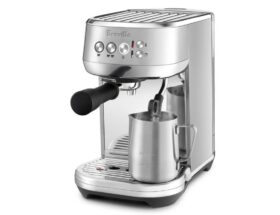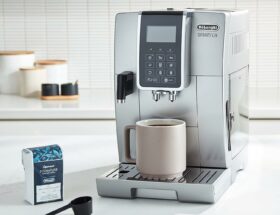
Ice in Coffee Grinder: Understanding the Risks and Alternatives
When it comes to making the perfect cup of coffee, some people like to think outside the box and experiment with different methods. One such method is putting ice in a coffee grinder to crush it before brewing. While it may seem like a convenient way to quickly cool down your coffee or add a touch of icy goodness, it’s essential to understand the potential risks involved. In this blog post, we’ll explain why putting ice in a coffee grinder can be hazardous and provide you with safer alternatives to achieve your desired results. We’ll also share some maintenance tips to keep your coffee grinder in top-notch condition. Let’s dive in!
Table of Contents
Ice in Coffee Grinder: Understanding the Risks and Alternatives
Are you tempted to put ice in your coffee grinder to achieve a refreshing icy blend? Think twice! While it may seem like a convenient hack, putting ice in a coffee grinder can actually cause serious damage. In this blog post, we’ll explore the potential risks of using ice in your grinder and offer safer alternatives to achieve the desired results. We’ll also provide valuable maintenance tips to ensure your coffee grinder stays in optimal condition.
The Risks of Putting Ice in a Coffee Grinder
While coffee grinders are designed to crush coffee beans, they are not built to handle the hard consistency of ice. Here are a few risks associated with putting ice in a coffee grinder:
- Potential Damage: Ice cubes can damage the grinder’s blades, motor, and other internal components. The hardness of ice can cause the blades to become dull or even break, leading to costly repairs or the need for a new grinder altogether.
- Unsafe Operation: Grinding ice in a coffee grinder increases the risk of overheating. The friction caused by crushing ice can generate excess heat, which may damage the grinder’s electrical components and pose a fire hazard.
- Inconsistent Grind: Ice cubes are larger and harder than coffee beans, which means they won’t grind evenly. This can result in an inconsistent grind size, affecting the flavor and quality of your coffee.
Alternatives to Crushing Ice in a Coffee Grinder
If you’re looking for ways to achieve a chilled coffee experience, here are some safer alternatives:
- Pre-crushed Ice: Purchase pre-crushed ice from your local store or use an ice crusher designed specifically for crushing ice cubes. This ensures a consistent texture and minimizes the risk of damaging your coffee grinder.
- Blender: Use a blender to crush your ice cubes. They are designed to handle the hardness of ice and can provide a fine, even consistency for your chilled coffee.
- Milk Frother: A milk frother can be an excellent option for creating a creamy and frothy iced coffee. Fill a cup with milk and froth it using a milk frother until you achieve the desired consistency. Then, pour it over a cup of coffee and add ice cubes to chill.
Utilize a blender to crush ice cubes for your chilled coffee. Blenders are specifically designed to handle the hardness of ice, resulting in a consistent texture without risking damage to your coffee grinder.
Coffee Grinder Maintenance Tips
While avoiding ice in your coffee grinder is crucial for its longevity, regular maintenance is also key. Here are a few maintenance tips to keep your coffee grinder in optimal condition:
- Regular Cleaning: Clean your coffee grinder after each use to prevent the accumulation of coffee bean residue. Use a small brush or a toothbrush to remove any leftover grounds.
- Grinder Burrs: If your grinder has burrs, it’s essential to clean them thoroughly. Follow the manufacturer’s instructions or consult a professional if you are unsure about the process.
- Proper Storage: Store your coffee grinder in a cool and dry place to prevent moisture damage. Avoid placing it near a stove or in direct sunlight.
- Regular Maintenance: Schedule regular maintenance for your coffee grinder. This ensures that any potential issues are detected early and resolved before they cause significant damage.
Remember, using ice in a coffee grinder can lead to irreparable damage. By following the alternative methods and implementing proper maintenance practices, you can enjoy a refreshing cup of iced coffee without risking your grinder’s well-being.
Step by Step Guide: Using Alternatives to Crush Ice for Your Coffee
Step 1: Freeze Coffee Cubes
Instead of using regular ice cubes, try freezing coffee ahead of time to maintain the flavor of your drink. Brew some extra strong coffee and pour it into ice cube trays. This way, when the coffee cubes melt in your drink, they won’t dilute the flavor.
Step 2: Use a Blender
If you don’t have an ice crusher or a coffee grinder, a blender can be a great alternative. Add the ice cubes to the blender and pulse until you have the desired consistency. However, make sure not to over-blend as it can quickly turn into slush.
Step 3: Choose Crushed Ice
If you prefer crushed ice in your coffee, consider purchasing it from a store instead. Many places sell bags of pre-crushed ice that you can keep in your freezer and use as needed. This eliminates the risk of damaging your coffee grinder and ensures a consistent result.
Step 4: Hammer and Ziplock Bag Method
If you’re feeling adventurous and don’t mind a little manual labor, you can crush ice using a hammer and a sturdy ziplock bag. Place the ice cubes in the bag, seal it tightly, and then wrap it in a kitchen towel. Use the hammer to gently crush the ice inside the bag until you achieve the desired consistency.
Wrap Up
Understanding the risks and alternatives to putting ice in your coffee grinder is crucial for maintaining the longevity of your appliance and ensuring the safety of your coffee brewing process. While it may seem convenient to use your grinder to crush ice, the potential damage it can cause outweighs the benefits. By following the suggested alternatives, such as using a blender or purchasing pre-crushed ice, you can still enjoy a refreshing cold coffee without risking your grinder’s functionality.
To keep your coffee grinder in optimal condition, it’s important to practice regular maintenance. Cleaning your grinder regularly, using a brush to remove coffee particles, and ensuring it’s dry before use are simple tips that can extend its lifespan and improve the quality of your coffee. Additionally, storing your grinder in a cool, dry place and avoiding any contact with water will help prevent any malfunctions or damage.
We hope this blog post has provided you with valuable insights into the risks of putting ice in a coffee grinder and offered practical alternatives to crushing ice. Remember, taking precautions and maintaining your coffee grinder will ensure the longevity of your appliance and a smooth coffee brewing experience.
If you have any questions or additional tips on coffee grinder maintenance, we’d love to hear from you. Leave us a comment below and join the conversation!
Recommended Links:
- How to Vietnamese Coffee: The Strong, Bold Coffee
- How to Hario V60: The Ultimate Guide to Making Perfect Coffee
- How to Siphon Coffee: The Slow and Elegant Way to Brew a Perfect Cup
- How to Aeropress: The Ultimate Guide to Making Amazing Coffee at Home









